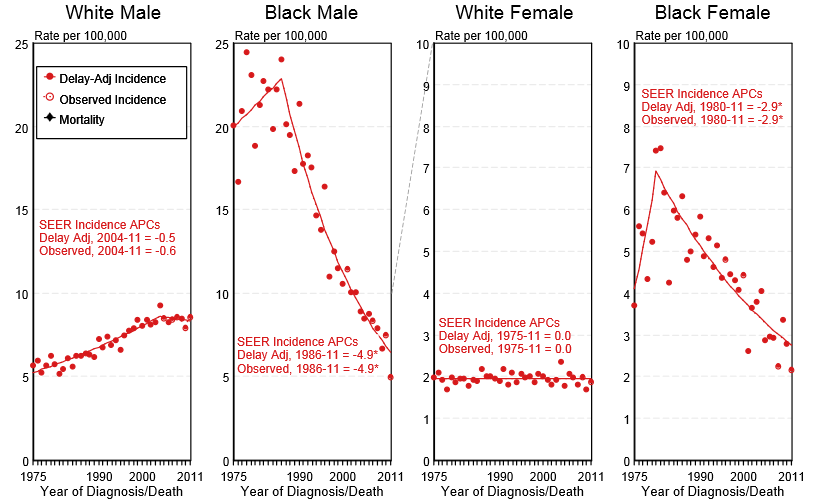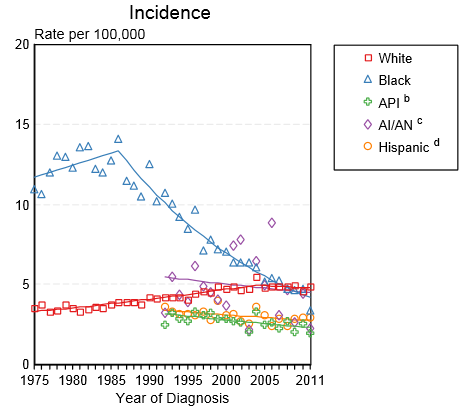Esophageal cancer epidemiology and demographics: Difference between revisions
Rim Halaby (talk | contribs) |
Rim Halaby (talk | contribs) |
||
| Line 62: | Line 62: | ||
[[Image:Incidence of invasive esophageal cancer by race in the United States.PNG|Incidence of invasive esophageal cancer by race in the United States between 1975 and 2011]] | [[Image:Incidence of invasive esophageal cancer by race in the United States.PNG|Incidence of invasive esophageal cancer by race in the United States between 1975 and 2011]] | ||
===Percent Distribution of | ===Percent Distribution of Invasive Esophageal Cancer by Histology=== | ||
Among patients with histologically confirmed cases of invasive esophageal cancer, the percent distribution of the types of the disease between 2007 and 2011 in the United States are:<ref name="SEER">Howlader N, Noone AM, Krapcho M, Garshell J, Miller D, Altekruse SF, Kosary CL, Yu M, Ruhl J, Tatalovich Z,Mariotto A, Lewis DR, Chen HS, Feuer EJ, Cronin KA (eds). SEER Cancer Statistics Review, 1975-2011, National Cancer Institute. Bethesda, MD, http://seer.cancer.gov/csr/1975_2011/, based on November 2013 SEER data submission, posted to the SEER web site, April 2014.</ref> | Among patients with histologically confirmed cases of invasive esophageal cancer, the percent distribution of the types of the disease between 2007 and 2011 in the United States are:<ref name="SEER">Howlader N, Noone AM, Krapcho M, Garshell J, Miller D, Altekruse SF, Kosary CL, Yu M, Ruhl J, Tatalovich Z,Mariotto A, Lewis DR, Chen HS, Feuer EJ, Cronin KA (eds). SEER Cancer Statistics Review, 1975-2011, National Cancer Institute. Bethesda, MD, http://seer.cancer.gov/csr/1975_2011/, based on November 2013 SEER data submission, posted to the SEER web site, April 2014.</ref> | ||
* [[Carcinoma]]: 99.1% | * [[Carcinoma]]: 99.1% | ||
Revision as of 14:32, 11 June 2014
|
Esophageal cancer Microchapters |
|
Diagnosis |
|---|
|
Treatment |
|
Case Studies |
|
Esophageal cancer epidemiology and demographics On the Web |
|
American Roentgen Ray Society Images of Esophageal cancer epidemiology and demographics |
|
Risk calculators and risk factors for Esophageal cancer epidemiology and demographics |
Editor-In-Chief: C. Michael Gibson, M.S., M.D. [1]
Overview
Esophageal cancer is a relatively rare form of cancer, but some world areas have a markedly higher incidence than others: China, India and Japan, as well as the United Kingdom, appear to have a higher incidence, as well as the region around the Caspian Sea.[1]
The American Cancer Society estimates that during 2007, approximately 15,560 new esophageal cancer cases will be diagnosed in the United States.[2]
The esophageal cancer incidence and mortality rates for people of African-Americans have been higher than the rate for Caucasians. [3] According to the NCI, incidence of adenocarcinoma of the esophagus, which is associated with Barrett's esophagus, is rising in the United States. This type is more common in Caucasian men over the age of 60.
Multiple reports indicate that esophageal adenocarcinoma incidence has increased during the past 20 yr, especially in non-Hispanic white men. Esophageal adenocarcinoma age-adjusted incidence increased in New Mexico from 1973 to 1997. This increase was found in non-Hispanic whites and Hispanics and became predominant in non-Hispanic whites. [4]
Epidemiology and Demographics
Prevalence
- In the United States, the age adjusted prevalence of invasive esophageal cancer is 0.0086% in 2011.[5]
Incidence
- The delay-adjusted incidence of invasive esophageal cancer in 2011 was estimated to be 4.51 per 100,000 persons in the United States.[5]
- In 2011, the age-adjusted incidence of invasive esophageal cancer was 4.45 per 100,000 persons in the United States.[5]
Age
- While the overall age adjusted incidence of invasive esophageal cancer in the United States between 2007 and 2011 is 4.4 per 100,000, the age-adjusted incidence of invasive esophageal cancer by age category is:[5]
- Under 65 years: 1.8 per 100,000
- 65 and over: 22.5 per 100,000
Gender
- In the United States, the age adjusted prevalence of invasive esophageal cancer by gender in 2011 is:[5]
- In males: 0.0147%
- In females: 0.0036%
- In the United States, the delay-adjusted incidence of invasive esophageal cancer by gender in 2011 is:[5]
- In males: 7.83 per 100,000 persons
- In females: 1.83 per 100,000 persons
- In the United States, the age-adjusted incidence of invasive esophageal cancer by gender on 2011 is:[5]
- In males: 7.72 per 100,000 persons
- In females: 1.80 per 100,000 persons
Shown below is an image depicting the delay-adjusted incidence and observed incidence of invasive esophageal cancer by gender and race in the United States between 1975 and 2011. These graphs are adapted from SEER: The Surveillance, Epidemiology, and End Results Program of the National Cancer Institute.[5]
Race
- Shown below is a table depicting the age adjusted prevalence of invasive esophageal cancer by race in 2011 in the United States.[5]
| All Races | White | Black | Asian/Pacific Islander | Hispanic | |
| Age-adjusted prevalence | 0.0086% | 0.0094% | 0.0070% | 0.0047% | 0.0048% |
Shown below is an image depicting the incidence of invasive esophageal cancer by race in the United States between 1975 and 2011.[5]
Percent Distribution of Invasive Esophageal Cancer by Histology
Among patients with histologically confirmed cases of invasive esophageal cancer, the percent distribution of the types of the disease between 2007 and 2011 in the United States are:[5]
- Carcinoma: 99.1%
- Epidermoid carcinoma: 33.7%
- Squamous cell carcinoma: 33.6%
- Adenocarcinoma: 60.7%
- Other specific carcinoma: 1.5%
- Carcinoma not otherwise specified: 3.2%
- Epidermoid carcinoma: 33.7%
- Other specific types: 0.3%
- Unspecified: 0.6%
References
- ↑ Stewart BW, Kleihues P (editors). World cancer report. Lyon: IARC, 2003. ISBN 92-832-0411-5.
- ↑ "What Are the Key Statistics About Cancer of the Esophagus?". Detailed Guide: Esophagus Cancer. 2006. Retrieved 2007-03-21. Unknown parameter
|publsiher=ignored (|publisher=suggested) (help); Unknown parameter|month=ignored (help) - ↑ "Incidence and Mortality Rate Trends" (PDF). A Snapshot of Esophageal Cancer. 2006. Retrieved 2007-03-21. Unknown parameter
|publsiher=ignored (|publisher=suggested) (help); Unknown parameter|month=ignored (help) - ↑ Kenneth J. Vega, M.D., M. Mazen JamaM.D.l (2000). "Changing pattern of esophageal cancer incidence in New Mexico". Changing pattern of esophageal cancer incidence in New Mexico. Retrieved 2007-03-21. Unknown parameter
|publsiher=ignored (|publisher=suggested) (help); Unknown parameter|month=ignored (help) - ↑ 5.00 5.01 5.02 5.03 5.04 5.05 5.06 5.07 5.08 5.09 5.10 Howlader N, Noone AM, Krapcho M, Garshell J, Miller D, Altekruse SF, Kosary CL, Yu M, Ruhl J, Tatalovich Z,Mariotto A, Lewis DR, Chen HS, Feuer EJ, Cronin KA (eds). SEER Cancer Statistics Review, 1975-2011, National Cancer Institute. Bethesda, MD, http://seer.cancer.gov/csr/1975_2011/, based on November 2013 SEER data submission, posted to the SEER web site, April 2014.

